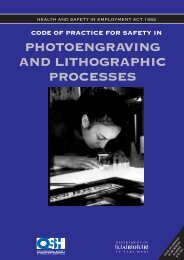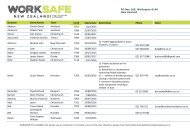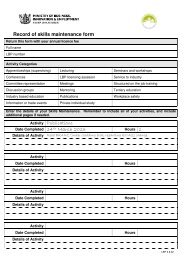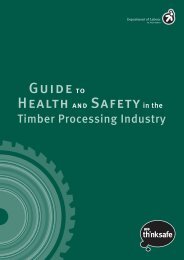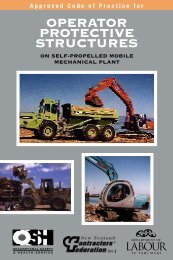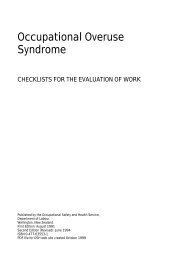Practical Guidelines for the Safe Use of Organic ... - Business.govt.nz
Practical Guidelines for the Safe Use of Organic ... - Business.govt.nz
Practical Guidelines for the Safe Use of Organic ... - Business.govt.nz
You also want an ePaper? Increase the reach of your titles
YUMPU automatically turns print PDFs into web optimized ePapers that Google loves.
Occupational <strong>Safe</strong>ty and Health In<strong>for</strong>mation SeriesPRACTICAL GUIDELINESFOR THE SAFE USE OFORGANIC SOLVENTSOCCUPATIONAL SAFETY& HEALTH SERVICEDEPARTMENT OFLABOURTE TARI MAHI
<strong>Practical</strong> <strong>Guidelines</strong> <strong>for</strong> <strong>the</strong> <strong>Safe</strong> <strong>Use</strong> <strong>of</strong> <strong>Organic</strong> Solvents wasprepared by OSH Health Services staff chaired by Mel Tyson, SeniorOccupational Health Scientist, Central Region.Published by:Occupational <strong>Safe</strong>ty and Health Service,Department <strong>of</strong> LabourWellington,New Zealand.Issued November 1992ISBN 0-477-03509-4P501-247/15000/1992
ContentsContents 3Introduction 4Duties <strong>of</strong> Employers and Employees 4What Are <strong>Organic</strong> Solvents? 5How Do You Know What to Look For? 5Training 6Physical Properties <strong>of</strong> Solvents 7Health Hazards 8How Much Exposure is Bad <strong>for</strong> You? 10Ways to Stop Harmful Solvent Pollution 11Ways to Control Harmful Solvents 12Measurement <strong>of</strong> Exposure 15Labelling and Storage 16First Aid 17Where to Find More In<strong>for</strong>mation 19
4 PRACTICAL GUIDELINES FOR THE SAFE USE OF ORGANIC SOLVENTSIntroductionThese guidelines give practical advice to people working every day withorganic solvents.Solvents are among <strong>the</strong> most commonly used chemicals in industry. Some100,000 New Zealand employees in many different jobs are regularly exposedto a variety <strong>of</strong> solvents, some <strong>of</strong> which can have serious health effects. Fewindustries are absolutely free <strong>of</strong> solvents.All solvents should be considered hazardous. How serious <strong>the</strong> threat is tohealth largely depends how much, how <strong>of</strong>ten and in what way someone isexposed.Employees in <strong>the</strong> following industries may be especially at risk:boat buildingplasticsprintingphotographicbuildingdry cleaningfootwearpaintingengineeringchemical manufactureThese guidelines have been written <strong>for</strong> both employees and employers, usingas little technical language as is possible. They follow <strong>the</strong> broad provisions <strong>of</strong> anew law — <strong>the</strong> Health and <strong>Safe</strong>ty in Employment Act 1992 —which appliesto nearly all places where people work (see following section).We encourage you to get toge<strong>the</strong>r and decide <strong>the</strong> best ways to stay healthywhen using organic solvents in <strong>the</strong> workplace.Duties <strong>of</strong> Employers and EmployeesEmployers have duties under <strong>the</strong> Health and <strong>Safe</strong>ty in Employment Act 1992to provide and maintain a safe and healthy work environment. They must alsoensure that employees are not exposed to hazards in <strong>the</strong> course <strong>of</strong> <strong>the</strong>ir work.Employers must establish systems <strong>for</strong> identifying and managing hazards.They must involve employees in <strong>the</strong> development <strong>of</strong> <strong>the</strong>se systems, including<strong>the</strong> procedures to be taken in <strong>the</strong> event <strong>of</strong> an emergency.Where <strong>the</strong>re is a significant hazard, <strong>the</strong> employer must, take action toeliminate it. Where elimination is not practicable, <strong>the</strong> hazard should beisolated. If nei<strong>the</strong>r <strong>of</strong> <strong>the</strong>se is practicable, exposure to <strong>the</strong> hazard must beminimised. This may require:
PRACTICAL GUIDELINES FOR THE SAFE USE OF ORGANIC SOLVENTS 5■■■■Ensuring that protective clothing and equipment is providedand used.Monitoring employees’ exposure to <strong>the</strong> hazard.Seeking <strong>the</strong> consent <strong>of</strong> employees to monitor <strong>the</strong>ir health.With in<strong>for</strong>med consent, monitoring employees’ health.If you are an employee, <strong>the</strong> Act gives you responsibility <strong>for</strong> your own safetyand health at work. This does not detract from <strong>the</strong> duties <strong>of</strong> your employer.This is not a complete description <strong>of</strong> employers’ duties under <strong>the</strong> Act and <strong>for</strong>fur<strong>the</strong>r in<strong>for</strong>mation you should see <strong>the</strong> OSH booklet A Guide to <strong>the</strong> Healthand <strong>Safe</strong>ty in Employment Act 1992 or contact your local OSH <strong>of</strong>fice.What Are <strong>Organic</strong> Solvents?A solvent is any liquid which can dissolve a substance. The name organicsolvent is used <strong>for</strong> a large group <strong>of</strong> <strong>the</strong>se chemicals which come from petroleum-basedproducts. They are <strong>of</strong>ten used as degreasing agents and paintthinners. They are also used to manufacture a wide range <strong>of</strong> o<strong>the</strong>r products,e.g. adhesives, fuels, pharmaceuticals and cosmetics.Many are volatile. They give <strong>of</strong>f a vapour and will evaporate quickly at roomtemperature. Not all give out a strong smell.CH 3<strong>Organic</strong> solvents are put in classes based on <strong>the</strong> chemicals in <strong>the</strong>m. Solventscan be members <strong>of</strong> <strong>the</strong> same chemical class and behave in similar ways butdiffer in how harmful <strong>the</strong>y are to people. The word toxic is <strong>of</strong>ten used whenreferring to a harmful solvent.It is not easy to know what <strong>the</strong>se effects on people might be. Solvents used inindustry are <strong>of</strong>ten mixtures <strong>of</strong> several chemicals, e.g. methylated spirits is ablend <strong>of</strong> methanol and ethanol. There may be as many as twenty substances insome organic solvents, e. g. white spirits, turpentine and kerosene.Chemical structure <strong>of</strong>toluene, a commonindustrial organicsolvent.Even <strong>the</strong> name spirit can confuse people: methylated spirits is a mixture <strong>of</strong>two alcohols and white spirit is a petrol-like blend <strong>of</strong> hydrocarbons. However,<strong>the</strong>y are very different in <strong>the</strong>ir toxic effects on people and <strong>the</strong> kind <strong>of</strong> hazard<strong>the</strong>y pose in <strong>the</strong> workplace.How Do You Know What to Look For?How do you ensure that <strong>the</strong>re will be no ill effects from <strong>the</strong> solvents used inyour workplace? The first step is <strong>for</strong> both employer and employees to knowabout and read <strong>the</strong> Material <strong>Safe</strong>ty Data Sheet <strong>for</strong> each product used.
6 PRACTICAL GUIDELINES FOR THE SAFE USE OF ORGANIC SOLVENTSMaterial <strong>Safe</strong>ty Data SheetsMaterial <strong>Safe</strong>ty Data Sheets (MSDS) should be available at <strong>the</strong> place <strong>of</strong> work<strong>for</strong> all to read. These sheets detail <strong>the</strong> hazards and set out <strong>the</strong> precautions <strong>for</strong>handling <strong>the</strong> chemical safely. MSDS should follow a design suggested in <strong>the</strong>Material <strong>Safe</strong>ty Data Sheet Code <strong>of</strong> Practice.Manufacturers and suppliers <strong>of</strong> chemicals provide Material <strong>Safe</strong>ty Data Sheetson each product and each solvent used in <strong>the</strong> workplace. The firm selling <strong>the</strong>chemical to <strong>the</strong> factory is required to supply <strong>the</strong>m with each purchase.■■Check that MSDS come with <strong>the</strong> product.Make sure everyone knows where <strong>the</strong>y are.How to <strong>Use</strong> <strong>the</strong> Material <strong>Safe</strong>ty Data SheetIndividual solvents can be found under a variety <strong>of</strong> chemical and trade names,so consult <strong>the</strong> MSDS carefully.■■■Look to see what <strong>the</strong> components <strong>of</strong> <strong>the</strong> product are.Check out <strong>the</strong> toxic properties.Follow <strong>the</strong> safety precautions.TrainingIt is important that everyone at work knows <strong>the</strong> solvent risks and which goodwork practices will reduce <strong>the</strong> risk to a low level. Training needs to be acompulsory part <strong>of</strong> <strong>the</strong> induction process <strong>for</strong> all new employees. It needs tocover health and safety issues as well as <strong>the</strong> use <strong>of</strong> <strong>the</strong> emergency facilities. Inmany cases, fur<strong>the</strong>r compulsory education <strong>for</strong> <strong>the</strong> existing staff members willalso be needed.Training should be specific. Its aim is to ensure each person on <strong>the</strong> staff:■■■■Can identify <strong>the</strong> solvents used in each stage <strong>of</strong> <strong>the</strong> process.Can recall <strong>the</strong> health and safety measures required <strong>for</strong> each solvent.Works through <strong>the</strong> Material <strong>Safe</strong>ty Data Sheets to interpret howstorage, safe use and emergency procedures, including fire drill, willoperate in each stage <strong>of</strong> <strong>the</strong> manufacturing process.Can carry out <strong>the</strong> proper first aid procedures <strong>for</strong> any solventaccident.
PRACTICAL GUIDELINES FOR THE SAFE USE OF ORGANIC SOLVENTS 7Physical Properties <strong>of</strong> SolventsVolatilityMany solvents are liquids with low boiling points, which means that <strong>the</strong>y willevaporate and <strong>for</strong>m vapour in <strong>the</strong> air when containers are left open. Theirvapours can be brea<strong>the</strong>d in and lead to health problems.What to Do:■■Store solvents in strong containers.Keep containers sealed or stoppered when not being used.FlammabilityKeep containerssealed or stopperedwhen not in use.In general, <strong>the</strong> more volatile solvents are <strong>the</strong> more hazardous.Many solvent vapours are highly flammable. They will readily create anatmosphere in which a fire can start: toluene and petroleum e<strong>the</strong>r, <strong>for</strong> example,have properties similar to petrol.This makes fire precautions extremely important.What to Do:■■■Work out evacuation routes within <strong>the</strong> factory.Keep evacuation routes free <strong>of</strong> any cluttering materials.Have fire drills <strong>of</strong>ten.Poisonous Gases in Case <strong>of</strong> FireNot all solvents are flammable; chlorinated solvents, such as111 - trichloroethane and carbon tetrachloride, are generally <strong>of</strong> very lowflammability, and o<strong>the</strong>rs have even been used as fire extinguishing agents.However, should halogenated solvents be involved in a fire at hightemperatures <strong>the</strong>y can produce phosgene, a deadly gas.Knowledge <strong>of</strong> what you are dealing with is vital to <strong>the</strong> proper methods <strong>of</strong>handling <strong>the</strong>se and o<strong>the</strong>r chemicals.Flash PointsThere is a high risk <strong>of</strong> explosion when flammable solvent is used attemperatures above its flash point.To reduce <strong>the</strong> risks:cupboard.
8 PRACTICAL GUIDELINES FOR THE SAFE USE OF ORGANIC SOLVENTSOR■<strong>Use</strong> a non-flammable solvent.Always take into account any increase in toxicity <strong>of</strong> a new material.At all times take special care to:■■■■Reduce <strong>the</strong> volume <strong>of</strong> flammable solvents present as far as possible.Prevent spills and leaks.Exclude sources <strong>of</strong> ignition such as naked lights, unsuitableelectrical equipment, static electricity hazards, hot surfaces andmechanical friction.Reduce <strong>the</strong> vapour concentration by ventilation/extraction systems.In addition, even high flash point liquids can catch fire and burn fiercely if<strong>the</strong>y are released as a spray or mist, or are heated above <strong>the</strong>ir flash point.Dangerous Reaction with Metal PowdersChlorinated hydrocarbons in contact with aluminium, magnesium and <strong>the</strong>iralloys can produce a spontaneous and sometimes explosive reaction. Thesemetals must be excluded when chlorinated solvents are used in a way where<strong>the</strong> solvent is likely to evaporate to dryness in <strong>the</strong> presence <strong>of</strong> metal powder.Health HazardsWays Solvents Can Enter Your BodySolvents can be absorbed into <strong>the</strong> body by three routes. They can be:■■■Inhaled into <strong>the</strong> lungs,Absorbed through <strong>the</strong> skin,Swallowed.Of <strong>the</strong>se three, inhaling a harmful vapour is <strong>the</strong> most common route.InhalationOnce inhaled, <strong>the</strong> solvent vapours come in direct contact with <strong>the</strong> bloodsupply in <strong>the</strong> lungs and dissolve into <strong>the</strong> bloodstream. They are <strong>the</strong>n carriedby <strong>the</strong> blood to <strong>the</strong> body’s organs. Here <strong>the</strong>y may damage <strong>the</strong> organ's ability t<strong>of</strong>unction.
PRACTICAL GUIDELINES FOR THE SAFE USE OF ORGANIC SOLVENTS 9AbsorptionIf solvents are in contact with <strong>the</strong> skin, <strong>the</strong>y may pass through and enter <strong>the</strong>bloodstream and be carried directly to <strong>the</strong> organs.Solvents differ in <strong>the</strong>ir ability to penetrate <strong>the</strong> skin’s protective fats and oils toreach <strong>the</strong> bloodstream but all will have a direct effect on <strong>the</strong> skin and cancause problems such as dermatitis.SwallowingSwallowing solvent may seem unlikely but avoid smoking, eating or drinkingwhile handling solvents.What Are <strong>the</strong> Warning Signs?The toxic effects <strong>of</strong> solvents may be noticed immediately, some time later orboth.Acute PoisoningThe first effects are <strong>of</strong>ten similar to drinking too much alcohol and may leadto poor work or a work accident. Effects will vary with <strong>the</strong> particular solvent,but will usually include:Solvents can beabsorbed into <strong>the</strong>body by three routes.■■■A light-headed feeling.Slower reaction time.Poorer co-ordination, balance and power <strong>of</strong> reasoning.This stage can be followed by:■■Nausea and dizziness getting more and more severe.Loss <strong>of</strong> consciousness (referred to as narcosis in some <strong>of</strong> <strong>the</strong>Material <strong>Safe</strong>ty Data Sheets).What to Do:■■Remove <strong>the</strong> person or people away from exposure to <strong>the</strong> vapour.Check <strong>the</strong> first aid instructions in this book and on <strong>the</strong> product labeland MSDS to see if <strong>the</strong>re is anything else to do to help.Recovery from <strong>the</strong> effects <strong>of</strong> acute exposure is usually both completeand fairly rapid once <strong>the</strong> victim is breathing clear air.Chronic PoisoningAfter years <strong>of</strong> repeated exposures, <strong>the</strong> typical later effects are:■■Mood changes.Tiredness.
10 PRACTICAL GUIDELINES FOR THE SAFE USE OF ORGANIC SOLVENTS■■■■Weakness.Persistent dermatitis.Effects on <strong>the</strong> liver and kidney.Solvents can also affect <strong>the</strong> peripheral nerves, <strong>the</strong> brain and spinalcord.Note: Not all solvents will have all <strong>of</strong> <strong>the</strong>se effects. Seekpr<strong>of</strong>essional advice when choosing products containing solventsand when substituting one solvent <strong>for</strong> ano<strong>the</strong>r.What to Do:■If you believe you may be suffering <strong>the</strong> effects <strong>of</strong> long-term exposure,see your doctor. If <strong>the</strong>re is a problem, you may need to change <strong>the</strong>way you do your job.How Solvents Affect <strong>the</strong> SkinSolvents dissolve <strong>the</strong> fat contained in human skin and remove <strong>the</strong> naturalprotective barrier, promoting <strong>the</strong> penetration and absorption <strong>of</strong> solvent ando<strong>the</strong>r chemicals which may be present. Even cleaning your hands in a solventsuch as turpentine can cause dermatitis, or make it worse.Solvents can cause skin rashes, most commonly on <strong>the</strong> hands, fingers and <strong>the</strong><strong>for</strong>earms. These rashes can be very irritating. If your exposure is short-term,<strong>the</strong>y are unlikely to last <strong>for</strong> long and will heal quickly.Repeated or prolonged exposure may result in chronic irritant dermatitis.This is <strong>of</strong>ten slow to heal and may leave <strong>the</strong> sufferer with a substantiallyincreased risk <strong>of</strong> repeated attacks.What to Do:Don't clean hands withsolvents: use a handcleanser instead.■■■<strong>Use</strong> hand cleansers. Do not wash your hands in a solvent, especiallyif you have any skin problems.Have and use properly designed equipment and a safe system <strong>of</strong>work.Wear protective gloves and clothing where necessary.How Much Exposure is Bad <strong>for</strong> You?The risk <strong>of</strong> injury or disease increases with how long you are exposed to <strong>the</strong>solvent and how much solvent vapour is in <strong>the</strong> air — its concentration.As individuals may differ in <strong>the</strong>ir responses to solvents, not all <strong>of</strong> <strong>the</strong> heal<strong>the</strong>ffects listed <strong>for</strong> a solvent need be experienced by exposed persons. However,
PRACTICAL GUIDELINES FOR THE SAFE USE OF ORGANIC SOLVENTS 11a good rule <strong>of</strong> thumb is that <strong>the</strong> longer <strong>the</strong> exposure (years) and <strong>the</strong> higher<strong>the</strong> dose, <strong>the</strong> greater <strong>the</strong> health risk.Mixed ExposureIn <strong>the</strong> workplace <strong>the</strong>re may <strong>of</strong>ten be mixtures <strong>of</strong> solvents, particularly inpaints and adhesives.Exposure to more than one solvent at <strong>the</strong> same time can give rise to greaterhealth risks. When a mixture <strong>of</strong> solvents is used, <strong>the</strong> “safe” level is <strong>of</strong>tenunpredictable.Drinking alcohol during <strong>the</strong> day may also increase <strong>the</strong> toxic risk.AddictionPeople can become addicted to some solvents such as trichloroethylene.Workplace Exposure StandardsIn New Zealand, <strong>the</strong> Workplace Exposure Standards (WES) help define <strong>the</strong>limits <strong>for</strong> exposure to airborne substances in <strong>the</strong> workplace. These give <strong>the</strong>limits <strong>for</strong> individual solvents and warn that special care is needed when <strong>the</strong>reis a mixture <strong>of</strong> solvents. When working out <strong>the</strong> safe level <strong>of</strong> solvent vapour in<strong>the</strong> air, add toge<strong>the</strong>r all <strong>the</strong> solvents which share <strong>the</strong> same biological effect.Do not think <strong>of</strong> <strong>the</strong> WES as <strong>the</strong> boundary between safety and danger. Peoplevary widely and some people may experience discom<strong>for</strong>t at levels well below<strong>the</strong> WES. There<strong>for</strong>e <strong>the</strong> level <strong>of</strong> any airborne contaminant should be reducedto <strong>the</strong> lowest practicable level below <strong>the</strong> WES.The booklet Workplace Exposure Standards and Biological Exposure Indicesis available from GP Books Ltd. and <strong>the</strong>ir agents.Ways to Stop Harmful Solvent PollutionEliminate or SubstituteWhenever possible, avoid using a substance that creates harmful vapour.■Find ano<strong>the</strong>r process which does not need this solvent.OR■Find ano<strong>the</strong>r substance which has <strong>the</strong> right chemical properties todo <strong>the</strong> job and is known to be less harmful.Where <strong>the</strong>se are not possible, engineering or o<strong>the</strong>r measures may be needed.
12 PRACTICAL GUIDELINES FOR THE SAFE USE OF ORGANIC SOLVENTSIsolateThe hazard can be isolated in a variety <strong>of</strong> ways through engineering and/orgood organisation <strong>of</strong> <strong>the</strong> work areas. The solvent process can be kept apartfrom o<strong>the</strong>r parts <strong>of</strong> <strong>the</strong> workplace, ei<strong>the</strong>r by position or by enclosing it. Alsoprovide good local or general workplace ventilation.VentilateWhere <strong>the</strong> danger is through breathing vapour into <strong>the</strong> lungs, ventilation is<strong>of</strong>ten used to reduce <strong>the</strong> concentration <strong>of</strong> <strong>the</strong> substance. Making air behaveproperly is technically very difficult, and <strong>the</strong> ventilation should be assessed byan experienced ventilation engineer.Local exhaust ventilation removes contaminated air directly from <strong>the</strong> source.It is far more effective and energy-efficient than ventilation systems, whichare designed to produce air changes in <strong>the</strong> complete room. General roomventilation may still be essential if local exhausting is not 100 percent effective.General room ventilation must work in with local exhaust ventilation <strong>for</strong> <strong>the</strong>most effective removal <strong>of</strong> atmospheric contaminants.Reduce <strong>the</strong> vapourconcentration byventilation andextraction systems.Good exhaust ventilation ensures that fumes are drawn away from <strong>the</strong> point<strong>of</strong> origin and away from <strong>the</strong> operator — not past <strong>the</strong> operator. The extractioncowling should be as close as possible to <strong>the</strong> source <strong>of</strong> <strong>the</strong> fumes. Efficientfume extraction leaves fresh, clean air in <strong>the</strong> breathing zone <strong>of</strong> <strong>the</strong> operator.Ways to Control Harmful Solvents<strong>Use</strong> Personal Protective EquipmentThe best thing to do is to prevent exposure to hazardous substances if at allpracticable. Where you cannot, control it. Prevention or adequate controlmust, so far as is reasonably practicable, be secured by means o<strong>the</strong>r thanpersonal preventive equipment. If prevention or adequate control cannot beachieved by o<strong>the</strong>r means, suitable personal protective equipment must beprovided. In addition, take all <strong>the</strong> o<strong>the</strong>r practical precautions you can.Protect <strong>the</strong> SkinSolvent-resistant gloves, boots and aprons are made from a range <strong>of</strong> syn<strong>the</strong>ticmaterials with varying permeability to solvents. The type <strong>of</strong> glove chosenneeds to protect against <strong>the</strong> specific solvent or mix <strong>of</strong> solvents being used.Un<strong>for</strong>tunately, very few glove materials are available which <strong>of</strong>fer full eighthourprotection and mechanical strength. Gloves which swell and distortallow solvents to penetrate to <strong>the</strong> skin in less than one hour <strong>of</strong> use. At higher
PRACTICAL GUIDELINES FOR THE SAFE USE OF ORGANIC SOLVENTS 13temperatures <strong>the</strong> break-through time is much shorter. Seek expert advicewhen choosing gloves. A table is provided overleaf which attempts to match<strong>the</strong> appropriate protective material to <strong>the</strong> type <strong>of</strong> solvent.When selecting <strong>the</strong> right glove <strong>for</strong> <strong>the</strong> job:■■■Choose materials listed good or excellent, not those with a fair orpoor rating.Choose gloves which are long enough to protect <strong>the</strong> worker <strong>for</strong> <strong>the</strong>application at hand.Select <strong>the</strong> glove thickness best suited <strong>for</strong> <strong>the</strong> application. If <strong>the</strong> jobcalls <strong>for</strong> maximum sensitivity and dexterity, <strong>the</strong> lighter weightgloves are best. Heavy-duty applications require a thicker glove.When exposure to <strong>the</strong> liquid solvent cannot be avoided:■Wear cotton overalls.<strong>Use</strong> personal protectiveequipment whenexposure to solventscannot be avoided byo<strong>the</strong>r means.■■Wear solvent-resistant boots and apron.<strong>Use</strong> a face visor to protect <strong>the</strong> face and eyes from splashes.The need to wear this gear throughout <strong>the</strong> day would suggest that <strong>the</strong> solventis being mishandled.When do You Need a Respirator?If you cannot reduce solvent vapours in <strong>the</strong> air to an acceptable level and<strong>the</strong>re is a chance <strong>of</strong> exposure in an emergency, use an approved respirator.What to Do:■In areas <strong>of</strong> high vapour concentration, always use full face respiratorswith an independent air supply.Cartridge-type respirators with <strong>the</strong> appropriate solvent cartridge areeffective only <strong>for</strong> concentrations below ten times <strong>the</strong> WES levels,even <strong>for</strong> short durations. If in doubt, always wear a full face respiratorfed with fresh air.■Make sure <strong>the</strong> respirator fits properly.Respirators are only effective when <strong>the</strong>y have been properly fittedand maintained. The person selling <strong>the</strong> respirator should be trainedin “fit testing” and be able to <strong>of</strong>fer appropriate advice. For example,half face respirators are not suitable <strong>for</strong> bearded users.A cartridge-typerespirator is suitable<strong>for</strong> some applicationsbut not in confinedspaces.For routine industrial use, respirators should be issued on apersonal basis. This ensures that an initial correct fitting willprovide a continuing good fit. It also eliminates <strong>the</strong> possibility <strong>of</strong>infection being transferred from person to person through <strong>the</strong>facepiece. Personal issue also helps <strong>the</strong> wearer anticipate when toreplace <strong>the</strong> cartridge.
14 PRACTICAL GUIDELINES FOR THE SAFE USE OF ORGANIC SOLVENTSGUIDE FOR SELECTING GLOVE MATERIALSSolvent Viton Nitrile Butyl Natural PVCRubberAcetone P P E G PAmyl acetate P P E F PCyclohexane E E P P FDimethyl <strong>for</strong>mamide P F E P PEthyl acetate P P G P PEthanol G E E E GHexane E E P P FIsopropanol E G E E GKerosene E E P P FMethanol F E E E EMethyl cellosolve P F G P -Methylene chloride G P F P PMethyl ethyl ketone P P E G P(MEK)Methyl isobutyl ketone P P G F F(MIBK)Perchloroethylene E F P P PPetroleum distillate G E P P PPropyl acetate P P G P FStoddard solvent E E P P F(white spirits)Styrene G P P P PToluene E F P P PTrichloroethylene E F P P PTurpentine E E P P FXylene E F P P PKEY:E: Excellent, G: Good, F: Fair, P: Poor, - No Data
PRACTICAL GUIDELINES FOR THE SAFE USE OF ORGANIC SOLVENTS 15■■Take care to maintain <strong>the</strong> respirator and cartridges.Store cartridges in sealed containers when not in use.You need to remove <strong>the</strong> cartridge from <strong>the</strong> respirator after each useand store it properly. If you don't put <strong>the</strong> cartridge away after eachuse, it will keep on absorbing any solvent in <strong>the</strong> air and becomeexhausted.Working in a Confined SpaceSolvents may build up to a dangerous level in confined spaces such as vessels,tanks, tankwagons, underground chambers, enclosed drains, unventilatedrooms and ovens. The hazards are potentially lethal.What to Do:■■■Never attempt such work without training.An experienced and responsible person must supervise <strong>the</strong> work.Plan <strong>the</strong> work properly be<strong>for</strong>e going in.Never work in aconfined space unlessyou have been trainedand follow <strong>the</strong> propersafety procedures.■■Get your employer's permission.Wear an air-fed respirator when entering a confined space.For fur<strong>the</strong>r in<strong>for</strong>mation, see <strong>the</strong> OSH booklet <strong>Safe</strong>ty in Confined Spaces.Measurement <strong>of</strong> ExposureAtmospheric (Air) SamplingWhere sampling is necessary to measure <strong>the</strong> concentrations <strong>of</strong> solvents in air,it will normally be best to contact a specialist in industrial hygiene <strong>for</strong> adviceon which method to use.Exposure to solvents will be most accurately measured by personal sampling.The personal sample should be collected as close as possible to <strong>the</strong> ”breathingzone’’ so that it gives an accurate reading. <strong>Use</strong> miniature equipment carriedby <strong>the</strong> worker during normal work operations.
16 PRACTICAL GUIDELINES FOR THE SAFE USE OF ORGANIC SOLVENTSBiological monitoring is unlikely to be used as a routine screening procedure.Consider using it if exposure is excessive or a potential health hazard,particularly as a result <strong>of</strong> skin absorption.Biological testing requires specialist skills, so seek advice from a qualifiedperson such as an occupational health physician.Labelling and StorageLabelsThe main purpose <strong>of</strong> a label is to tell people what <strong>the</strong> product is. However,labels <strong>of</strong>ten have o<strong>the</strong>r important in<strong>for</strong>mation about <strong>the</strong> contents <strong>of</strong> <strong>the</strong>product and <strong>the</strong> way it is to be handled, transported and used. More in<strong>for</strong>mationabout labels is set out in NZS 5433:1988 Code <strong>of</strong> practice <strong>for</strong> <strong>the</strong>transport <strong>of</strong> hazardous substances on land. These requirements are specificallycovered by <strong>the</strong> Dangerous Goods Act 1974 and <strong>the</strong> Toxic Substances Act1979 and <strong>the</strong> associated regulations.What to Do:Display a poisonsymbol on label towarn people whomay not understandEnglish.■■■Label all containers so that at all times employees and managementknow what substances <strong>the</strong>y are working with.Ensure <strong>the</strong>re are warning labels to indicate <strong>the</strong> hazardous nature <strong>of</strong><strong>the</strong> substance and <strong>the</strong> procedures to be used in an emergency.Show a poison symbol on <strong>the</strong> container to warn people who cannotread or understand English.Sample label <strong>for</strong> a productcontaining solvents.
PRACTICAL GUIDELINES FOR THE SAFE USE OF ORGANIC SOLVENTS 17StorageStore bulk quantities (more than 5 litres) <strong>of</strong> solvent or substances containinga significant percentage <strong>of</strong> flammable solvent in a flamepro<strong>of</strong> cabinet orstoreroom.What to Do:Prohibit smoking inand around solventstorage areas.■■■■■■■Store in a cool place, away from ignition sources.Keep storage area well ventilated to prevent solvent vapouraccumulating.Isolate <strong>the</strong> storage area from <strong>the</strong> workplace.Have <strong>the</strong> floor with raised edges around it to contain spills.Equip <strong>the</strong> storage area with appropriate fire fighting equipment.Keep <strong>the</strong> quantity outside <strong>the</strong> storage area to a minimum.Prohibit all smoking in and around <strong>the</strong> storage area.First AidEmergency FacilitiesAll employees should know <strong>the</strong> first aid <strong>for</strong> any chemical <strong>the</strong>y use. First aidprocedures <strong>for</strong> specific solvents used in <strong>the</strong> workplace should also be available.Refer also to <strong>the</strong> MSDS.Emergency washing facilities such as a shower or hose attachment should beavailable close to <strong>the</strong> work area to wash contaminated skin or clothing. An eyefountain should also be available close to employees to dilute eye splashes inemergencies.Skin ExposureAim to dilute <strong>the</strong> solvent immediately:■■Remove contaminated clothing, using appropriate gloves if available.Wash contaminated skin with lots <strong>of</strong> soap and water from a shower,hose or bucket.An emergency eyewash fountainshould be available,close to wherepeople are working.
18 PRACTICAL GUIDELINES FOR THE SAFE USE OF ORGANIC SOLVENTSInhalationTo help a victim <strong>of</strong> over-exposure to solvent vapours:■■Immediately remove <strong>the</strong> victim from <strong>the</strong> atmosphere in which <strong>the</strong>over-exposure occurred.Keep <strong>the</strong> victim warm and quiet.If unconscious, if breathing is distressed, or if victim is cyanosed (blue incolour):■■■■Ensure <strong>the</strong> airway is open — press <strong>the</strong> headbackwards and lower jaw <strong>for</strong>wards so that<strong>the</strong> chin juts out.Place <strong>the</strong> victim in <strong>the</strong> recovery position.Support breathing by mouth to mouthresuscitation. <strong>Use</strong> CPR if necessary.Seek medical attention urgentlyPlace a victim <strong>of</strong>solvent inhalation in<strong>the</strong> recovery position.Swallowing■If conscious, give plenty <strong>of</strong> water to drink.Do not cause vomiting.■■■If unconscious do not give anything by mouth. Remove false teeth,clean mouth <strong>of</strong> solvent, mucus and vomit. Follow instruction <strong>for</strong>unconscious victims given above.Refer to first aid instructions and <strong>the</strong> MSDS <strong>for</strong> specific solvents. Foradditional in<strong>for</strong>mation ring <strong>the</strong> National Poisons and HazardousChemicals In<strong>for</strong>mation Centre, listed in <strong>the</strong> emergency servicessection <strong>of</strong> <strong>the</strong> telephone directory.Obtain medical attention urgently.Splash ProtectionIf <strong>the</strong> solvent gets into <strong>the</strong> eye:■■■Wash immediately with clean running water, lifting both lidsrepeatedly while doing so and keeping <strong>the</strong> eye open.Continue to wash <strong>the</strong> eye without break <strong>for</strong> at least 15 minutes. If<strong>the</strong> irritation still persists after this, seek medical attention withoutdelay.If <strong>the</strong> affected person is wearing contact lens, <strong>the</strong> eyes should beflushed constantly until <strong>the</strong> person is able to remove <strong>the</strong> contactlens.
PRACTICAL GUIDELINES FOR THE SAFE USE OF ORGANIC SOLVENTS 19Where to Find More In<strong>for</strong>mationIn<strong>for</strong>mation concerning <strong>the</strong> methods <strong>of</strong> using solvents safely are availablefrom many sources. Some are listed below and anyone using solvents shouldbe able to contact <strong>the</strong>se people <strong>for</strong> in<strong>for</strong>mation.■■■■■■All employers should have a working knowledge <strong>of</strong> <strong>the</strong> materialsbeing handled.Material <strong>Safe</strong>ty Data Sheets (MSDS) should be available at <strong>the</strong>place <strong>of</strong> work <strong>for</strong> all involved people to read.The manufacturer or <strong>the</strong> distributor <strong>of</strong> <strong>the</strong> solvent should haveprovided <strong>the</strong> MSDS when delivering <strong>the</strong> solvent. If <strong>the</strong>se cannot befound, ask <strong>the</strong> supplier to send replacement MSDS and all <strong>the</strong>in<strong>for</strong>mation necessary to use <strong>the</strong> solvent safely.Occupational health services operated or contracted by <strong>the</strong>employer will have full in<strong>for</strong>mation and knowledge <strong>of</strong> <strong>the</strong> hazardsposed by <strong>the</strong> solvents and <strong>the</strong> correct methods <strong>of</strong> controlling <strong>the</strong>risk.Local branches <strong>of</strong> <strong>the</strong> Occupational <strong>Safe</strong>ty and Health Service <strong>of</strong> <strong>the</strong>Department <strong>of</strong> Labour (OSH) are available to answer questions orprovide “broad brush” advice on request. See over page <strong>for</strong> a list <strong>of</strong>addresses.The appropriate union will have full in<strong>for</strong>mation and knowledge <strong>of</strong><strong>the</strong> hazards posed by <strong>the</strong> solvents and <strong>the</strong> correct methods <strong>of</strong>controlling <strong>the</strong> risk.




![Task analysis worksheet [161 KB PDF] - Business.govt.nz](https://img.yumpu.com/51400981/1/190x135/task-analysis-worksheet-161-kb-pdf-businessgovtnz.jpg?quality=85)

